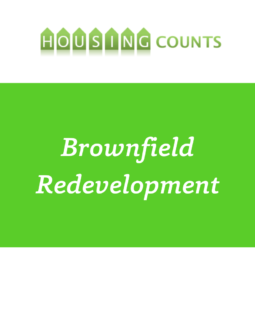Redevelop Brownfield Sites for New Housing
Brownfields, as defined by the U.S. Environmental Protection Agency (EPA), are real property, the expansion, redevelopment, or reuse of which may be complicated by the presence or potential presence of a hazardous substance, pollutant, or contaminant. A brownfield can range in size from small sites such as a corner gas station or neighborhood auto shop to larger sites or structures including factories, train stations, and hospitals. The EPA estimates that there are more than 450,000 such properties in the United States.
Communities throughout the country are successfully redeveloping brownfield sites into housing, commercial and public spaces. Cleaning up and reinvesting in these properties increases local tax bases, facilitates job growth, provides housing opportunities, utilizes existing infrastructure, takes development pressures off of undeveloped land, and both improves and protects the environment. Reusing buildings also helps preserve historic structures with unique architectural style and local character. This is an important factor in the preservation of neighborhood character. A historic or familiar building becomes a fixture of a community and its loss results in a loss to the community.
Most redevelopment sites need to conduct due diligence to understand the historic use of the site which may lead to site Phase I and Phase II investigation and subsequent cleanup in order to safely accommodate the desired end-use. Redevelopment activities provide numerous advantages for housing opportunities. However, the presence of contamination will have to be addressed in an environmentally sound and health-supporting way. This may cause delays and additional costs which have to be accounted for. Federal, state, regional and county level resources are available to assist with remediation of brownfield sites in order to reduce the costs associated with cleaning a site. This is critical to increasing the supply of healthy and affordable housing because any increase in costs makes the housing less affordable, unhealthy for the residents and less attractive for developers. This results in costs to the taxpayer and to the community in the future if not addressed adequately.
How are brownfield sites used as redevelopment opportunities for housing?
Redeveloping brownfield sites for housing is achievable with committed local support and partnerships with the private sector. Infill and urban redevelopment often supports higher density and is attractive where transportation, jobs and services exist. These infill sites also work well for mixed-use development. Sites can range from small corner lots to large redevelopment areas that combine parcels. Along with vacant or blighted land, the reuse of buildings (sometimes called vertical brownfields) provides opportunities to preserve community structures by converting the use. Reusing buildings can preserve architectural character which may help maintain community identity, and limits demolition waste to landfills.
What problems are solved when redeveloping brownfields?
Contamination from superfund and brownfield sites may cause significant site constraints that lead to decisions from existing communities to favor development outside of its core. When public funds are invested in existing built communities, instead of in vacant open spaces beyond municipal borders, other public infrastructure service costs are reduced.
- Revitalizing existing communities allows metropolitan areas to utilize existing infrastructure, such as roads, water, sewer, electrical and telephone services. This reduces the cost of constructing expensive new infrastructure. It also prevents increases in energy consumption and vehicular emissions that affect both air quality and water quality.
By reusing existing buildings and infrastructure, property reclamation efforts mean that less farmland and natural areas will be converted to urban use. - Reclaiming brownfield properties leads to the reduction of contamination and blight concerns, often having ancillary community stabilization benefits to nearby properties and neighborhoods.
- Sustainable reuse of abandoned buildings limits demolition waste, a major source of waste which contributes over 65 million tons of material to our nation’s landfills and other solid waste management facilities per year.
What brownfield redevelopment tools are most applicable to housing?
Brownfield assistance can be used at the earliest stages of site consideration by providing financial and technical assistance for investigation and Response Action Plan development activities. Grant resources for cleanup activities need to be requested prior to remediation occurring.
